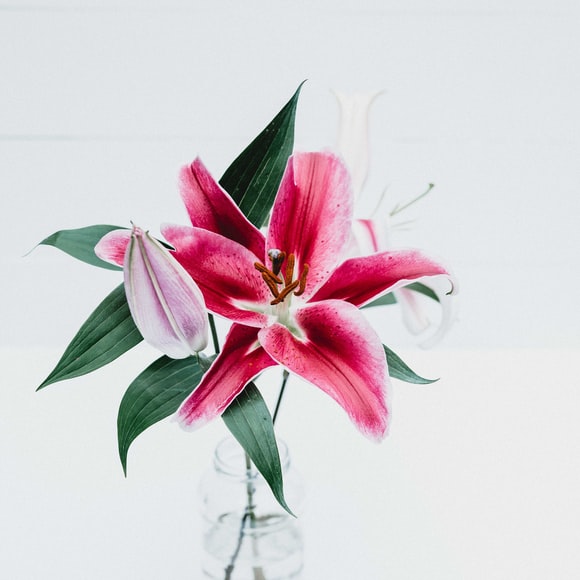
Lilium species throughout the ages
Lilies are the oldest of all cultivated flowers and have a history spanning thousands of years. Their beautiful form has been recorded in almost every realm of human existence, from ancient herbals and tapestries, gardening literature and poetry, to homewares and the Internet.
Throughout the ages, lilies have played an important role in the well-being of many native cultures. Bulbs of certain lily species of North America and Asia were sought by local tribes and villages, as a practical food source and for medicinal purposes.
Chinese culture
Native to China, Lilium brownii and Lilium lancifolium (pictured above) were very common in the wild and widely cultivated as commercial root crops. Favored for their white, edible bulbs, they were prepared using various means, from oven roasting, boiling in sugar and water, or added to soups.
Other species, including L. davidii, L. pumilum and L. concolor, were also used in cooking, and as a dried herb in traditional medicine, so as to maintain good health.
The ancient belief of symbolic plants and their associated meanings has prevailed throughout Chinese culture, and 'bai he' (translated 'a hundred united') is based on the bulbs' numerous overlapping scales, representing the idea of harmony. In some areas, sliced lily scales are sometimes served as a special wedding dish with ginkgo nuts, in the wish that the marriage may run smoothly.
Native American culture
Like the Chinese, Native American culture also carries the belief that plants add significance to life, and images of lilies and other native flowers have been found on garments and beaded bags dating from the 1800s.
A number of specific lilies were well known by different tribes, such as L. columbianum in the Pacific Northwest, and L. philadelphicum in eastern areas of Canada and the USA. Being widespread, Lilium superbum and Lilium canadense (pictured above) were the most admired of the North American species.
Bearing similarities to the potato, wild lily bulbs of L. columbianum were collected by the women of First Nation tribes, and usually cooked for immediate consumption by either boiling or steaming. Bulbs were also dried or flattened into thin cakes and stored for future use, or alternatively, ground into a flour to thicken soups.
Beyond being a food commodity, the bulbs were also respected for their healing powers. Crushed and applied externally, such poultices were used in the treatment of wounds, swelling, bruises and snake bites.
Herbals, art and symbolism
Numerous historical texts refer to lilies, including the words of the early European writer, Pliny the Elder (23-79 AD) who expressed the lily as being “as fair and noble as the rose”.
Dioscorides, a Greek botanist and physician in the 1st century, observed the healing virtues of lilies, particularly Lilium candidum. In his herbal book De Materia Medica, he wrote of the flowers being used in an ointment for comforting the sinews.
Revered by the ancient Greeks, this lily was also associated with the goddess, Juno, and later named the Madonna Lily (pictured above) by Christians, symbolizing the purity of the Virgin Mary. It was grown in monastery gardens, appearing in many medieval herbals and illuminated manuscripts.
During the Renaissance, the lily was painted in great works of art by Fra Filippo Lippi, Simone Martini and Leonardo da Vinci, and later in the paintings of the Pre-Raphaelite artist, Dante Gabriel Rossetti.
Botanical art paralleled the quest for new and exotic plants, and was at its peak during the 19th Century. Most, if not all, lily species have been illustrated at one point or another, and detailed images by artists such as Redouté and Fitch, are still in demand with collectors and designers today.
Expeditions and collectors
By the 17th Century, several different species of lily were well-known in Europe, those being L. chalcedonicum, L. martagon, L. bulbiferum and L. candidum. These were depicted in the books of famed herbalists, Parkinson and John Gerard.
However, it was the botanical expeditions that plant hunters undertook in the 1800s and 1900s that led to major discoveries of lily species from China and Japan. Vast quantities of bulbs were loaded onto ships and were lucky to survive the long journey back to Europe and England.
Those that survived the voyage were introduced to the public via horticultural fairs and plant nurseries. Three well-known lily species that made their way from the Asian continent were L. longiflorum, L. formosanum and L. regale.
Discovered in Japan, Lilium longiflorum is similar in appearance to the Madonna Lily with its yellow anthers and pure white petals. Nowadays, it is most famously known in North America as the Easter Lily. Hybrid variants of L. longiflorum have become a favorite choice in floristry and wedding bouquets, such as 'Snow Queen' and 'White Heaven'. Many thousands of these hybrid flowers are grown as cut flower crops every year in large commercial greenhouses on Oregon coast.
Secondly, Lilium formosanum (pictured above) is native to Taiwan and thrives in subtropical climates. As a result, it has naturalized in many other parts of the world. Called the Formosa Lily (meaning 'beautiful'), it was first cultivated in the late 1800s.
Lilium regale (or Regal or Royal Lily – pictured below) was first discovered in China in 1903 and brought to the USA between 1908 and 1910. It has been known as a lily for cottage gardens and is one of the easiest Lilium species to grow.
In today's world
From the 20th century onwards, lilies have spread throughout the world, crossing continents and cultures, and into a complex world of genetic breeding. Thousands of hybrid varieties have come into existence since the 1950s, and each year new ones are registered by private and commercial breeders.
Despite being sidelined by an ever-growing number of hybrids, easy-to-grow species such as L. regale, L. auratum, L. candidum, L. speciosum, L. longiflorum and L. lancifolium continue to hold their own in many gardens.
However for those lesser-known species of lilies growing in unprotected wilderness areas, it is a different matter with habitats being damaged and/or destroyed by land developments and deforestation. In California in particular, lilies such as L. occidentale (Western Lily) and L. pardalinum var. pitkinense (Pitkin Marsh Lily) are registered as endangered species in places where they have grown for centuries.
With a future at risk, planting native species is a protective action gardeners can take to ensure likely survival of a truly historic group of plants.




